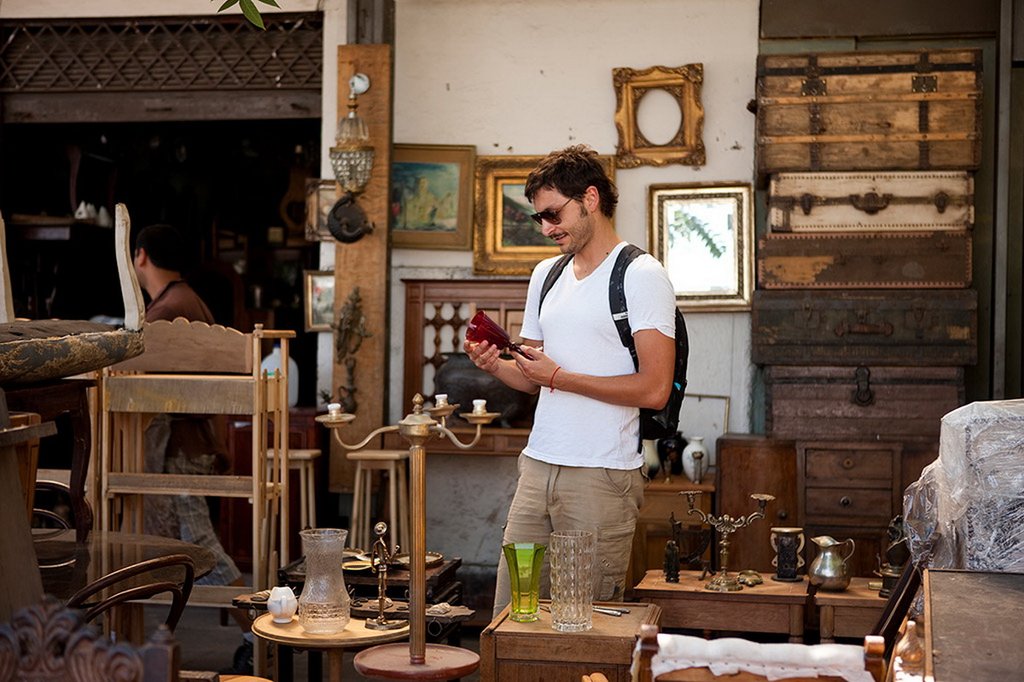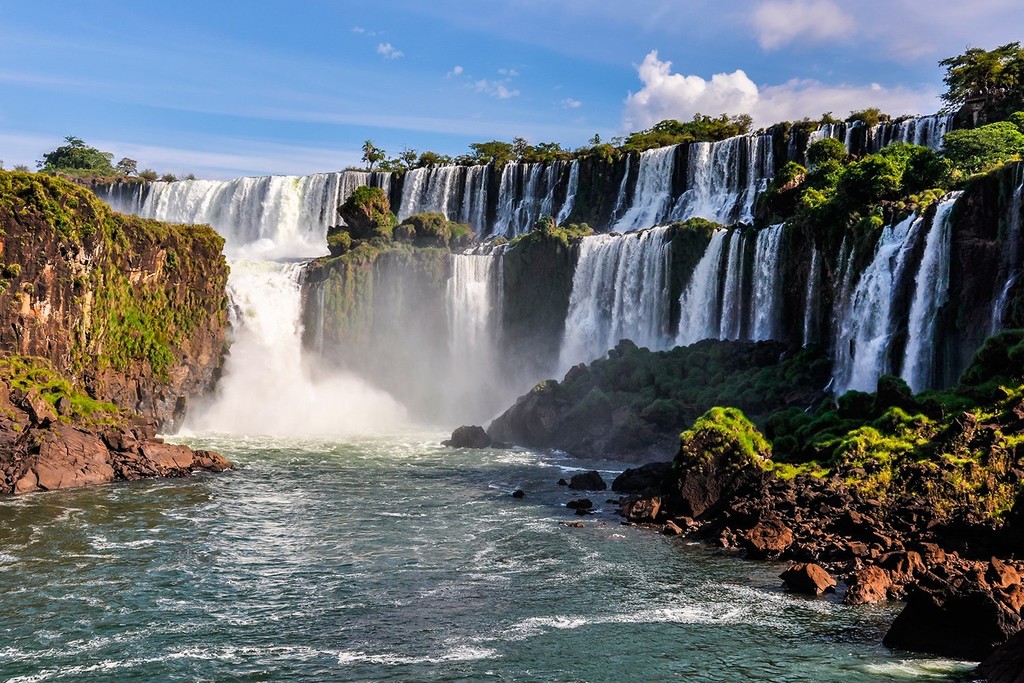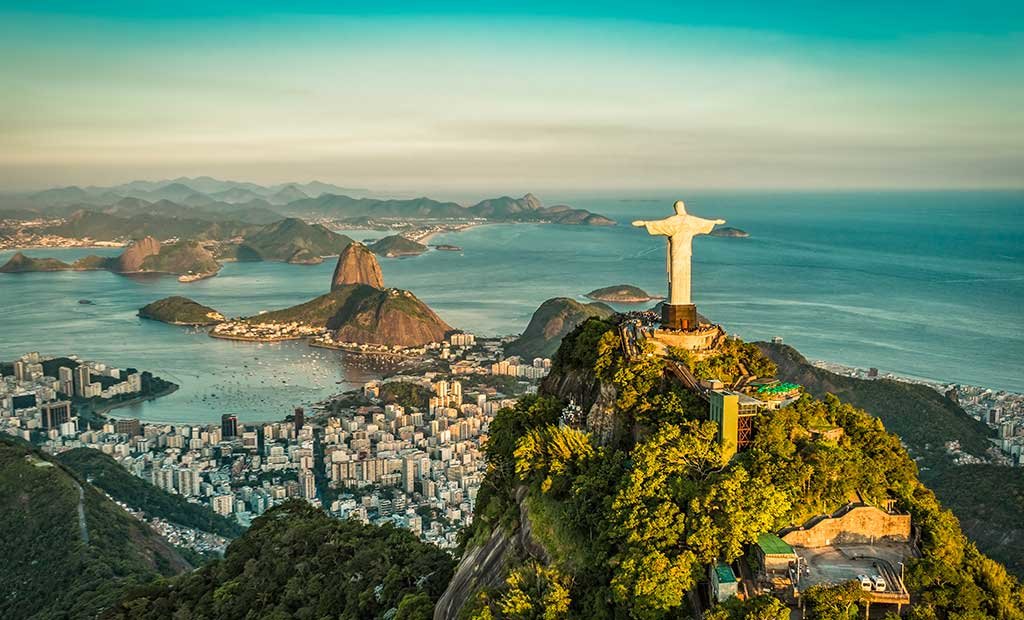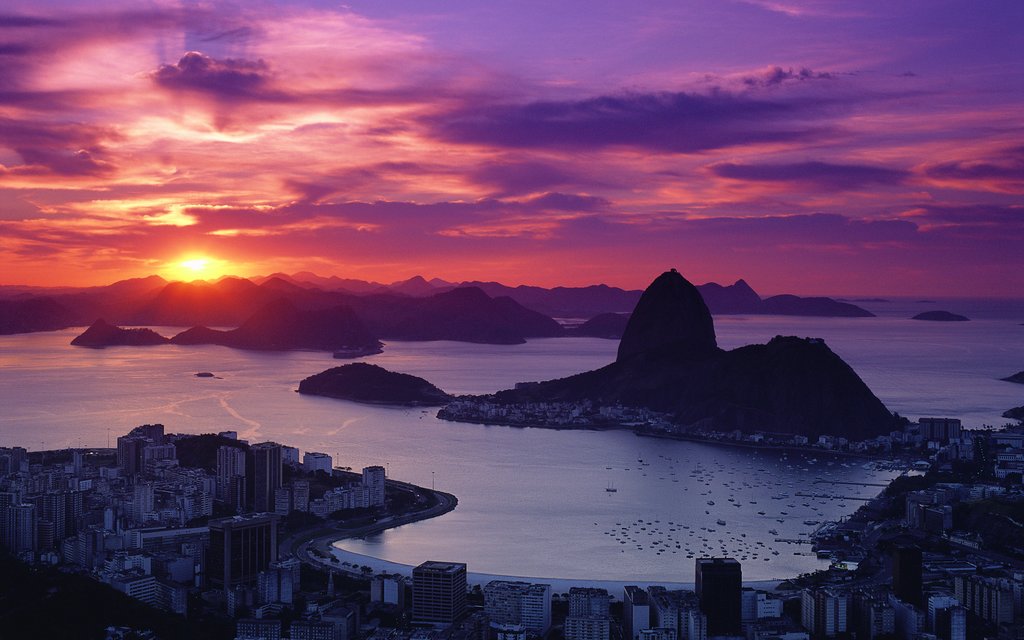Highlights
- Tour Santiago's historic & modern highlights
- Discover Argentine culture & cuisine with a tango dinner show in Buenos Aires
- Trek around the world's largest waterfall complex at Iguazú
- Relax on Rio de Janeiro's famous beaches
Brief Itinerary
| Day | Highlights | Overnight |
|---|---|---|
| Day 1 | Welcome to Santiago de Chile! | Santiago |
| Day 2 | Santiago de Chile Half-Day City Tour | Santiago |
| Day 3 | Free Day in Santiago de Chile | Santiago |
| Day 4 | Fly to Buenos Aires | Buenos Aires |
| Day 5 | Buenos Aires Half-Day City Tour & Tango Show | Buenos Aires |
| Day 6 | Free Day in Buenos Aires | Buenos Aires |
| Day 7 | Fly to Puerto Iguazú | Puerto Iguazú |
| Day 8 | Iguazú Falls Full-Day Excursion | Puerto Iguazú |
| Day 9 | Free Day at Iguazú Falls | Puerto Iguazú |
| Day 10 | Fly to Rio de Janeiro | Rio de Janeiro |
| Day 11 | Rio de Janeiro Corcovado Excursion | Rio de Janeiro |
| Day 12 | Free Day in Rio de Janeiro | Rio de Janeiro |
| Day 13 | Depart Rio de Janeiro |
Detailed Itinerary
Day 1: Welcome to Santiago de Chile!

Welcome to Chile! Upon arrival at Santiago International Airport, a driver will meet you and transfer you to your hotel. You'll have the rest of the day to explore the city at your leisure. Nestled in the foothills of the Andes, Chile's capital of Santiago is a modern and bustling metropolis with pockets of historic ambiance scattered throughout its historic center. Stroll the cobblestones of Barrio Bellavista, visit the 16th century Plaza de Armas, or hike to the top of Cerro San Cristobal for magnificent views.
For dinner be sure to get out of the hotel and enjoy a culinary adventure in the city. In recent years Santiago has emerged as a global foodie destination. Chilean chefs are reinventing traditional dishes like empanadas, cazuelas (stews), and seafood with ingredients harvested from the northern deserts and southern Patagonian regions. You can find great restaurants and wine bars not only in the Bellavista neighborhood but also in the revitalized historic barrios of Yungay and Italia.
Day 2: Santiago de Chile Half-Day City Tour

Today is devoted to discovering Santiago on foot, with a half-day guided tour of the city's iconic sights. Along the way, you'll explore characterful old neighborhoods like Republica and Concha y Toro, learn about the city's origins and modern growth at the La Moneda Government Palace, and tour the grand Plaza de Armas, located in Santiago's historic center. Discover the incredible history within the four corners of this expansive stone plaza, founded back in 1541. Nearby sits the impressive Catedral Metropolitana, a neoclassical church circa 1748, with towering twin bell towers dominating the north side of the plaza. Later on, continue to the eastern parts of the city to admire the modern buildings that have shaped a new and modern Santiago.
Day 3: Free Day in Santiago - Optional Day Trip to Valparaíso & Viña del Mar

Spend today at your leisure, exploring more of Santiago at your own pace or getting out of the city with an optional excursion to Chile's Pacific Coast and the seaside towns of Valparaíso and Viña del Mar. Starting in the UNESCO World Heritage Site of Valparaíso, explore this colorful metropolis known as the artistic and bohemian soul of the country. Filled with street art, music, and poetry, Valparaíso is a throwback to the turn of the 20th century, when electric trollies coasted along the waterfront and lurching funicular elevators carried passengers to the highest points in the city. No matter where you go, you can always find sweeping views looking out over the colorful houses to the Pacific Coast and the blanket of blue water running out to the horizon.
After lunch, you'll continue to Viña del Mar, an upscale coastal resort city teeming with shopping complexes, commercial high-rises, boutiques, and well-manicured gardens. Its beaches and boulevards, surrounded by palm trees and beautiful parks, have earned it the name of 'Ciudad Jardin" (Garden City) and it remains a popular weekend and holiday destination for the people of Santiago.
As your day at the seaside draws to a close, you'll be transferred back to your hotel in Santiago for the evening.
Day 4: Fly to Buenos Aires

This morning a transfer takes you to the airport to catch your departing flight for Buenos Aires. Renowned as the "Paris of South America" and the "Queen of El Plata," Argentina's capital city is defined by passion. This is exemplified in the rich tango heritage and its citizens' limitless enthusiasm for fútbol (soccer), which is by far the country's most popular sport.
When you arrive at the airport, your driver will be waiting to take you in a private car to your hotel where you can relax after a long flight. But make no mistake: the city will beckon you. So after a quick recharge, be sure to venture out into the welcoming arms of Buenos Aires and explore.
Day 5: Buenos Aires - Half-Day City Tour & Tango Show

This morning, you will embark on a half-day guided tour of Buenos Aires' highlights, by foot and by transfer where appropriate. You will get to see the 16-lane Avenida 9 de Julio, the widest city street in the world, with the Obelisco, perhaps the most famous icon of the city, in the middle of it. This obelisk was built in 1936 to commemorate 400 years of Spanish settlement in the Río de la Plata area. You will also see the iconic city thoroughfare Avenida Corrientes, known for its theatre scene.
The first stop will be in the Plaza de Mayo, where you can visit the Cathedral and the Cabildo (Old City Hall). After that, your trip will continue towards San Telmo, a charming district characterized by its old colonial houses, cobblestoned streets, and tango scene. Continue to the traditional working-class La Boca neighborhood, located in the south of the city, where you will get to see the colorful zinc houses that make up this area of Buenos Aires and that used to be the refuge and home for the first immigrants and artists.
Your next port of call will be Puerto Madero, the old city port, now transformed into one of the city's most exclusive residential and dining areas. Next, you visit Palermo, one of Buenos Aires' liveliest barrios (neighborhoods), and hugely popular with tourists thanks to its excellent museums, restaurants, bars, and cafés. Here you may also get to spend some time in Bosques de Palermo (Palermo Woods), where 740 acres of beautiful gardens and ponds are surrounded by elegant buildings.
Finally, the last point in the tour is Recoleta, a classy district of Parisian-style architecture and high-end boutiques where you can visit Recoleta Cemetery. Eva Perón is just one of the many famous Argentines laid to rest in this striking landmark, often cited as one of the world’s best cemeteries—wander through aisles of elaborate marble mausoleums designed in Art Deco, Baroque, and Art Nouveau architectural styles. Recoleta also has many bars, cafes, and fancy restaurants worth a visit.
In the evening, you will be taken by your English-speaking guide to historic San Telmo, the hub of the Buenos Aires tango scene for a dinner, tango, and folk music show.
Chat with a local specialist who can help organize your trip.
Day 6: Free Day in Buenos Aires

Spend today exploring Buenos Aires at your own pace. Some suggested activities include:
- Visit the Obelisco, which might be the city's most famous monument. This obelisk (which even Argentines admit is a little too reminiscent of the Washington Monument) is worth a visit for its location alone. It sits right in the middle of Avenida 9 de Julio, which boasts a whopping 16 lanes and is one of the widest avenues in Latin America.
- Stop by the Teatro Colón, one of South America's premier opera houses, which is known worldwide for its incredible acoustics. Even if you plan to take a tour or catch a show here later, it's still worth passing by to take in the exterior architecture. The Colon's neoclassical façade has made it one of the most handsome buildings in Buenos Aires since its opening in 1908.
- Stroll through Puerto Madero, an upscale waterfront neighborhood adjacent to downtown. Puerto Madero may be the "new money" finance center of Buenos Aires, but it's also one of the most pleasant places to walk in the city. Take a romantic stroll by crossing over the canal on the Puente de la Mujer ("Woman's Bridge") at sunset.
- Dine at a classic Argentine parilla (steakhouse). When night falls, enjoy a thick, juicy steak (Argentina has some of the best beef in the world) drizzled with delicious chimichurri sauce (made of garlic, herbs, and vinegar). Buenos Aires is a late-night city, and it's not uncommon for locals to have dinner well past nine in the evening, especially on weekends.
If you would like, you can also book an optional evening of tango at a historic Buenos Aires coffee house and take a tango lesson.
Day 7: Fly to Puerto Iguazú

After breakfast, transfer to the Buenos Aires airport for your flight to Puerto Iguazú. This city is home to the Argentinian side of Iguazú Falls, the world's largest waterfall system. Upon arrival in Puerto Iguazú, you will transfer to your hotel, and rest up for a full day excursion tomorrow.
Day 8: Iguazú Falls Full-Day Excursion

After breakfast at your hotel, a driver will pick you up and drop you off at the entrance of Iguazú National Park, on the Argentine side of the falls. This is where you will begin the day's adventure, a full-day tour that involves walking the three circuits that weave around the waterfall. Each of these offers different vantage points from which to view the water.
- The Upper Circuit (1 hour) is made up of 2,624 feet (800 m) of walkways elevated above the jungle floor to avoid disrupting the natural paths of indigenous fauna. On this route, you'll see the upper portion of Iguazú, including countless panoramic vistas of the surrounding cascades.
- The Lower Circuit (2 hours) is 5,250 feet (1,600 m) long and is also made up of elevated walkways, which go directly below and around the falls. This circuit takes you near the base of the falls and right up to the crashing torrents of water. You'll be able to feel the magnitude of the waterfall from up close.
- The Devil's Throat (2 hours) is the star of the show. A small tourist train leaves from the Cataratas Station and travels 18 minutes to Garganta Station, where you'll find restrooms, a snack bar, and the start of the path. You'll walk 3,937 feet (1200 m) over the river until you reach the viewing platform. From there you'll be able to peer 269 feet (82 m) down into the water, as the highest of Iguazu's Falls thunders all around you.
At the end of the tour, the driver and guide will pick you up and take you back to your hotel.
Day 9: Free Day at Iguazú Falls

Today you have free time to continue exploring the Iguazú Falls area. A great way to spend the day is to visit the Brazilian side of the waterfalls, which offers some very different perspectives on this magical natural attraction. Be sure to bring your passport for crossing the border from Argentina to Brazil.
This area of Iguazú may lack the number of hiking routes found on the Argentine side, but it makes up for it with a wealth of amenities in the form of conveniences and restaurants with terraces overlooking the falls. Upon arrival at the Visitor's Center, you'll board a double-decker bus that embarks on a 30-minute ride into the park.
After you jump off the bus, your first stop is a balcony that offers panoramic views of the Argentine side of the falls (be sure to keep your camera at the ready). You'll then hike 3,116 feet (950 m) along the Iguazú River until you reach the falls on the Brazilian side. The walkway passes over the river to the Salto Floriano (Floriano Falls). This magnificent wall of plunging water makes quite an impression, as do the vistas of the lower Iguazú River and the Devil’s Throat Canyon.
At the end of the path, a panoramic elevator offering more spectacular waterfall views transports you back to where your bus will be waiting to return you to the visitor center. You will then be transferred back to your hotel.
Day 10: Fly to Rio de Janeiro

A transfer takes you to the Puerto Iguazú airport today, where you'll catch a flight to Rio de Janeiro. A city famous for its long beaches, sultry samba, relaxing days, and hot nights, Rio's carioca culture is defined by a zest for life, a passion for music, and a love for friends and family. It's the perfect spot for a bit of fun and a lot of relaxation. Upon arrival, you'll be transferred to your hotel, where you can get settled in and then head out to explore the city.
Day 11: Rio de Janeiro Corcovado Excursion

Today, after breakfast at your hotel, you'll embark on a half-day tour to one of Rio de Janeiro's most famous attractions. Visit the iconic statue named Christ the Redeemer, which is located at the top of Corcovado Hill just west of the city. From this granite peak in the Tijuca Forest, you'll get a panoramic view of Rio's city center as well as the ocean and surrounding mountains that will take your breath away. You'll also have the opportunity to climb to the statue's viewing platform by historic train, which will make this an even more special experience.
Day 12: Free Day in Rio de Janeiro

Today you're free to explore the city at your leisure. Some suggested activities include:
-
Laze on Río's beaches. Río de Janeiro's beaches are deservedly famous and for nearly a century have been a global destination for jet-setters looking for fun, sun, and sand. The two most iconic beaches are Copacabana and Ipanema. Both are popular with locals but Ipanema is often more crowded because the surf is a bit better for swimming. Don't miss other, more off-the-beaten-path beaches, like Grumari and Prainha, both located on the far southwest coast. Not only are they less crowded than the aforementioned options but the scenery is just as stunning.
-
Visit Lapa. The Lapa neighborhood, located near the city center, is a bohemian enclave full of life, art, music, and passion. On the weekends it's ground zero for Rio's party scene, and you simply can't miss spending a Friday or Saturday evening strolling the streets, enjoying the food and cocktails served by street vendors, bar-hopping, dancing, and generally comingling with the exuberant locals filling the area. It's also home to the famous Escadaria Selarón, also known as the "steps of Lapa." The decor of this brightly painted staircase is the handiwork of Chilean-born artist Jorge Selarón and is one of the most famous selfie spots in the city.
- Sample Brazilian cuisine. It wouldn't be a trip to Río (or anywhere in Brazil, for that matter) if you didn't try the local rodizio bbq (churrasco). "Rodizio" is a Portuguese word that means "rotating," which is how the meat here is cooked: on rotating spits, typically over fiery coals. In these all-you-can-eat restaurants, servers take the skewers right from the fire to your table and carve copious amounts of various cuts of grilled meat onto your plate. Another must-try staple of carioca cuisine is feijoada, a rich dish of black beans, pork, and beef that is slow-cooked for hours. It's typically served on a Saturday because it takes so long to prepare, and it will take you nearly as long to emerge from the food coma after consuming it.
Day 13: Depart Rio de Janeiro

It's time to transfer to the Rio de Janeiro airport and begin your journey home! Not to worry—South America will be waiting for you with open arms when you come back for another adventure of a lifetime.
More South America Itineraries
Looking for more inspiration for your trip to South America? Check out these other Chile, Argentina, and Brazil itineraries, with outdoor adventures, cultural trips, and best-of tours to hit the highlights.
Or, describe your ideal trip and we will connect you with a local specialist to make it happen.
